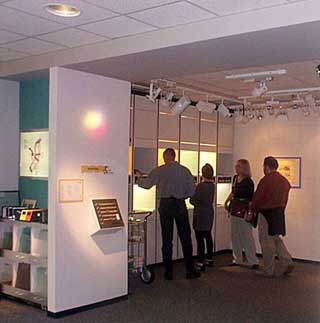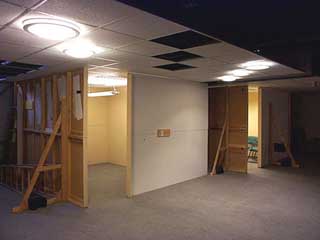
Outlook Index
Surveys
DJC.com
Next >
Back <
Design lab sheds light on energy conservation
Sponsored by Seattle City Light and several energy conservation and environmental groups, the Seattle Design Lab on Capitol Hill helps companies develop effecient lighting systems -- before installation.By RANDY SMITH
Lighting Design Lab
The Pacific Northwest is in the throes of the biggest population and construction boom in history, and energy use is skyrocketing. Electric utilities are constantly searching for new sources of energy. A rich resource is the energy wasted by inefficient equipment in our buildings.

|
Now in its tenth year, the Lighting Design Lab on Seattle's Capitol Hill educates the Northwest's lighting market about quality design and efficient technologies. Lab staff offer classes, consultations, mockups, model studies, a Web site and a technical reference library. The lighting education center is sponsored by Seattle City Light, the Northwest Energy Efficiency Alliance, Puget Sound Energy, other electric utilities, and environmental organizations.
It is usually far less expensive to make efficiency improvements than build new power plants. Lighting is a large part of the energy equation, especially in commercial buildings. The cost of lighting, and removing the heat the lights produce in a typical office building could account for 40 percent of the utility bill. The Lighting Design Lab is often able to show how savings of 30 percent or more are possible, simply by making better choices in the marketplace. The bonus is that the choices for greater efficiency usually mean better color, lower maintenance and less flicker and glare, too.
Architects, engineers, designers, building operators and even homeowners use the Lab to discover their best options for solving lighting problems. Most of the services of the Lab are free or very low cost, because of the support of their sponsors in Alaska, British Columbia, Idaho, Montana, Oregon and Washington.
One way the Lab helps solve lighting problems is through classes, forums and workshops. This year Lab staff will visit over 15 different cities in the region for presentations on lighting and daylighting. The classes range from lunch-time seminars to day-long workshops and cover everything from advances in new lighting products to using controls to integrate daylight and electric light. Professionals receive continuing education credits through these classes, assisting with meeting the requirements for recertification by organizations like the American Institute of Architecture, NCQLP and others.
Two commercial lighting specialists, a daylighting specialist and a residential lighting specialist offer free consultations on lighting problems. The purpose of the consultations is to determine how much light is needed, where it is needed and what options are available. The Lab does not sell any products, so advice is not based on commissions or sales quotas.
A 1,200-square-foot mock-up studio with movable ceilings is the heart of the Lighting Design Lab. Your design team can create the final design of a space, down to the last detail, and critically evaluate the success of each component. Boeing, Microsoft, Starbucks, Nike and others have saved themselves millions of dollars and thousands of headaches by using the mock-up studio at the Lighting Design Lab. There is no cost for simple mockups, and the charge for complex studies is based on the additional time and materials. Experienced stage technicians and electricians are on call to make sure every detail of your mockup is expertly installed.
Although the Lab assists companies on electric lighting, its daylighting services sets them apart. An adjustable heliodon table and artificial sun help designers perform shade and shadow analysis of building models. A large artificial sky provides the ability to model building performance under overcast skies. The daylighting specialist assists with bringing in the sunlight people crave without creating glare or overloading air conditioning systems.

|
New research has shown that daylight makes people more productive, increases sales and increases worker satisfaction. Effective use of daylight is at the cutting edge of architecture in the new millenium. The cost of designing, creating and running our buildings is just a fraction of the cost of the people inside those buildings. Therefore, design decisions for the sake of initial cost or so-called efficiency that make workers and businesses less productive are the most expensive mistakes that you can make.
Three years ago the Lighting Design Lab expanded into cyberspace with a Web site – www.northwestlighting.com. This site offers a wealth of content on lighting products and design techniques, guides to Lab services and downloads of nearly every handout available at the Lab itself. There is a virtual tour of the Lab, postings of notable lighting locations and extensive links to other lighting and energy sites. Northwestlighting.com has a free e-mail newsletter to keep you up-to-date on lighting events in the Pacific Northwest.
A full-service technical reference library is open to the public at the Lighting Design Lab, with hundreds of lighting catalogs, a collection of technical references and standards, and a wide selection of periodicals. The library also houses videotapes, lighting software and energy code information. The library and the Lab is open 8 a.m. to 5 p.m., Monday through
Friday, but the Web site is open 24 hours, seven days a week. Classes take place both at the Capitol Hill facility and around the region. Consultations happen at the Lab, on-site and in cyberspace. You can get answers to your questions in person, on the telephone, by fax and by e-mail. The Lighting Design Lab is located at 400 E. Pine St. For more information, call (800) 354-3864, or send a fax at (206) 329-9532. Email inquiries may be sent to info<\@>northwestlighting.com
Randy Smith is the librarian and Webmaster for the Lighting Desing Lab.
Top | Back | Environmental Outlook | DJC.com Copyright ©1995-2000 Seattle Daily Journal and djc.com.
Comments? Questions? Contact us.